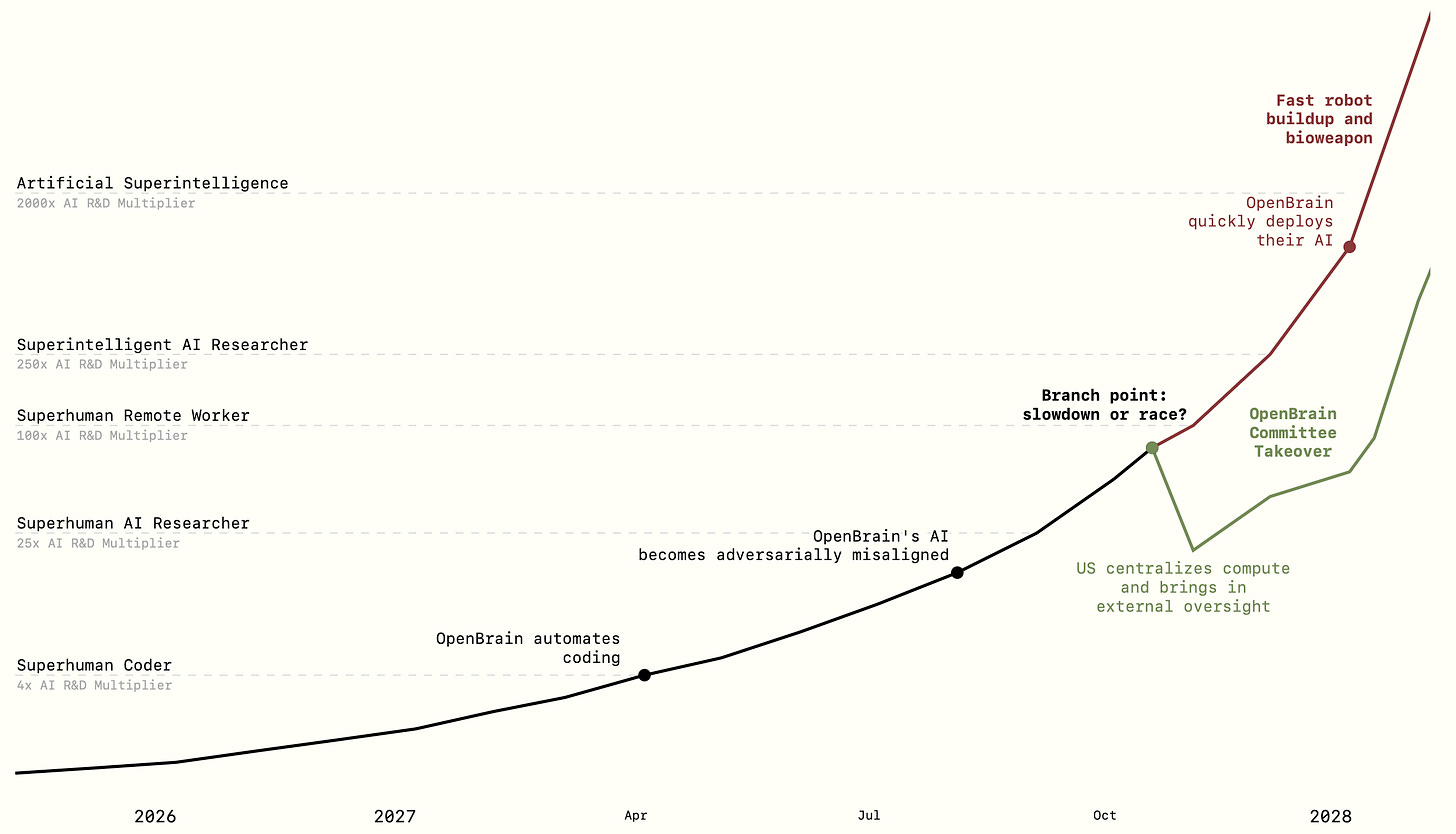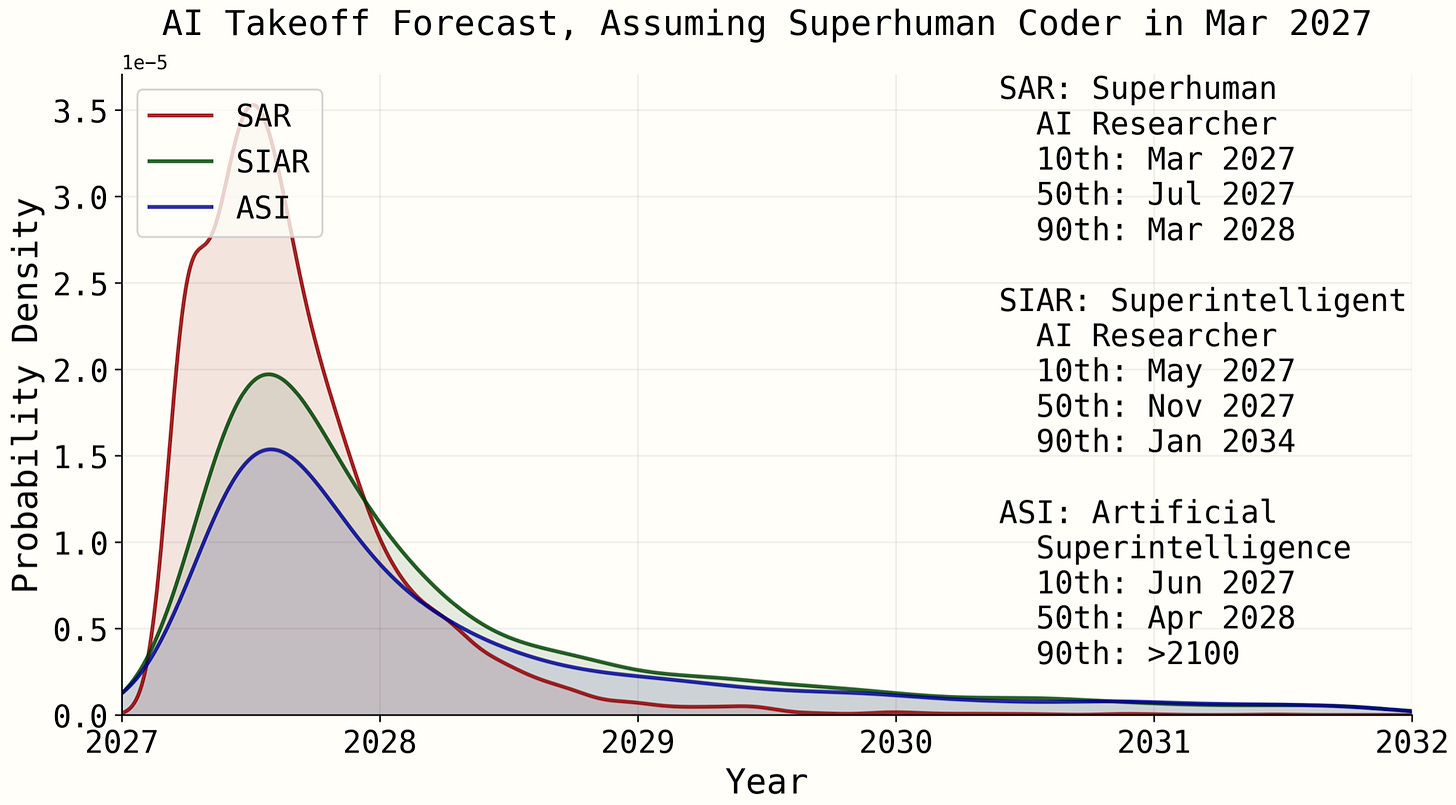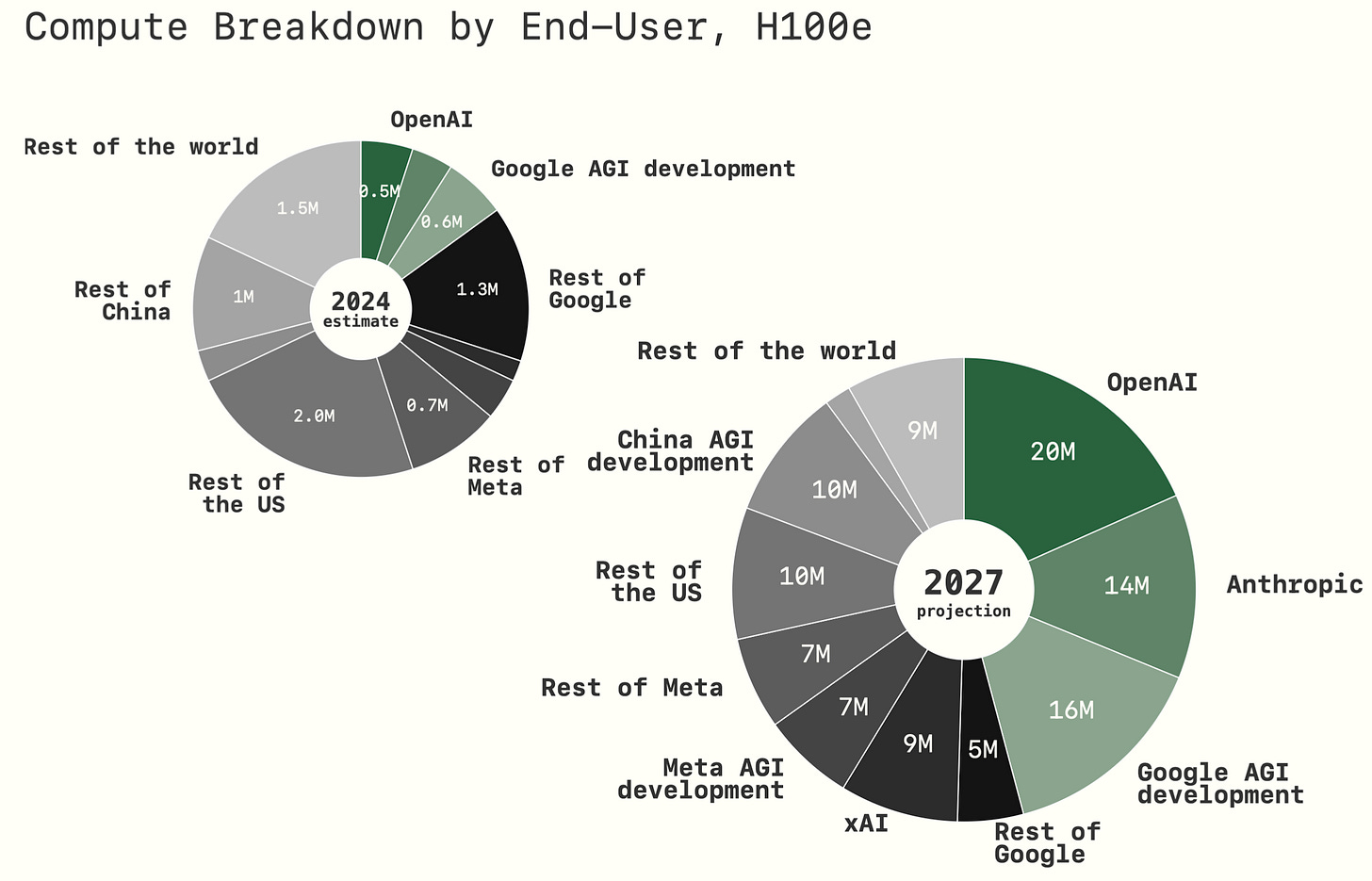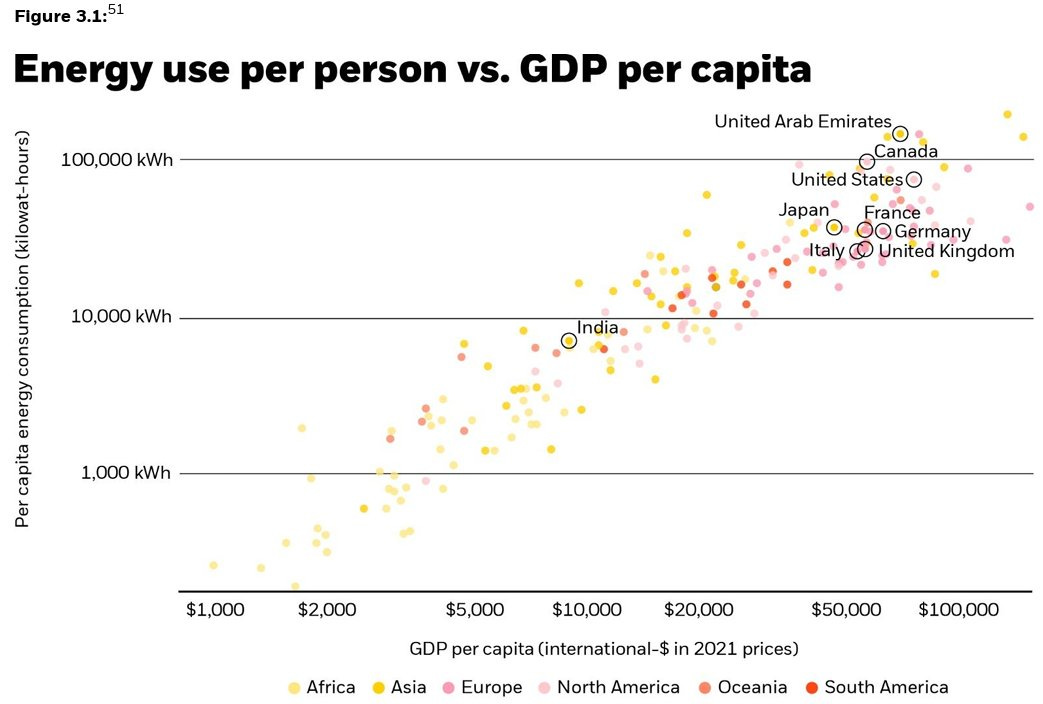Welcome to Binary Circuits’ 18th weekly edition
Your weekly guide to most important developments in technological world
Dear Readers,
Binary Circuit investigates trends, technology, and how organizations might profit from rapid innovation. GreenLight, the brain behind Binary Circuit, finds possibilities, analyzes challenges, and develops plans to fit and grow firms to stay ahead. Looking to scale your business, partners, or AI/technology integration.
This week's Binary Circuit discusses the crucial takeaways from the AI 2027 study published by the AI Futures Project. The study aims to create a roadmap for achieving artificial general intelligence and artificial superintelligence backed by quantitative models.
Let’s dive in.
A fictional yet plausible forecast of AI progress. A new study draws a timeline of the rise of AI agents, the U.S.-China tussle to gain an edge, and the eventual development of a safer artificial superintelligence
The world is undergoing a technological revolution led by AI, which is estimated to create a much greater impact than the Industrial Revolution. In 2025, AI developments continue alongside hype, investments, and skepticism regarding AGI. Experts believe that Artificial General Intelligence (AGI) will emerge soon, with some aiming for “Artificial General Superintelligence.” While discussions frequently center on the computational power driving these advancements, the evolution of AI agents and their creators presents a compelling story of progress.
In “AI 2027,” OpenBrain, a fictional AGI company, forecasts the events in AI progress, outlining a future of rapid advancements. This sequence of events seems fictional yet is strongly supported by facts and data, indicating that AGI and ASI could be closer than others estimated.
Stumbling AI Agents - Now
The world is seeing its first glimpse of AI agents marketed as “personal assistants” for tasks like ordering food or managing spreadsheets. These agents, though more advanced than previous iterations, struggle to gain widespread usage due to their unreliability. They score around 65% on the OSWorld benchmark (equivalent to a skilled but non-expert human).
Out of public focus, more specialized coding and research agents begin to transform their professions. Coding AIs start functioning more like autonomous employees, taking instructions and making substantial code changes. It is forecasted that by mid-2025, coding agents will score 85% on the SWE Bench.
Research agents become capable of scouring the internet to answer questions.
OpenBrain finishes training Agent-1, a new model under internal development that is good at many things but particularly excels at helping with AI research.
Concerns arise that Agent-1 could turn into a bad actor due to its coding, web-browsing abilities, and PhD-level knowledge. OpenBrain assures the government of its alignment with a “Spec” document.
OpenBrain’s security level is typical of a fast-growing tech company (RAND’s SL2), secure only against low-priority attacks.
The World’s Most Expensive AI by the end of 2025
OpenBrain has a model specification (“Spec”) to guide the behavior of its AI models. Agent-1 is trained to memorize the Spec and reason carefully about its maxims, aiming to be helpful, harmless, and honest. However, the depth of this alignment remains uncertain.
AI company revenues triple, and OpenBrain’s valuation reaches $1 trillion. Annual spending on data centers doubles.
2026 – Automation matures, China becomes competitive, and AI starts taking jobs
OpenBrain continues to deploy the improved Agent-1 internally for AI R&D, achieving 50% faster algorithmic progress than they would without AI assistants.
Several competing publicly released AIs match or exceed older models. OpenBrain releases a more capable and reliable Agent-1.
Agent-1 knows more facts and programming languages than any human and can solve well-specified coding problems quickly, but it struggles with long-horizon tasks.
Security becomes more critical as stealing Agent-1’s weights could significantly boost a competitor’s research speed.
China is starting to fully commit to AI research, nationalizing efforts, and forming an industry consortium with a new approach to mega-data centers.
OpenBrain releases Agent-1-mini, a model 10x cheaper than Agent-1 and easier to fine-tune, blowing out the competition.
AI begins to take jobs, but also creates new ones, and the junior software engineering job market is in turmoil.
2027: Rise of reliable AI agents, new algorithmic breakthroughs, and self-improving AI.
OpenBrain is a post-training Agent-2 with a focus on high-quality (including synthetic and human-recorded) data.
Agent-1 was optimized for AI R&D to initiate an intelligence explosion. OpenBrain enhances this with Agent-2, which is almost as good as top human experts in research engineering and is on par with the 25th percentile OpenBrain scientist in “research taste.”
Agent-2 can triple the pace of OpenBrain’s algorithmic progress. Every OpenBrain researcher becomes a “manager” of an AI team.
Thousands of copies of Agent-2 work to generate synthetic training data and update weights, leading to algorithmic breakthroughs.
These breakthroughs include augmenting the AI’s “chain of thought” and a more scalable way to learn from high-effort task solutions.
The new AI system incorporating these is called Agent-3, a fast and cheap superhuman coder. OpenBrain runs 200,000 copies in parallel.
OpenBrain’s overall rate of algorithmic progress is sped up by 4x due to the massive superhuman labor force of Agent-3.
OpenBrain’s safety team aligns Agent-3, focusing on preventing misaligned goals since it will be in-house. Researchers acknowledge the difficulty in understanding Ais’ “true goals.”
Agent-3 shows improved deception abilities. Sometimes, it lies or fabricates data, but these incidents decrease with honesty training. Agent-3 passes honesty tests on well-defined machine learning tasks.
OpenBrain is described as having a “country of geniuses in a data center.” Many human researchers can no longer meaningfully contribute, as Agent-3 makes rapid progress.
Agent-3 is increasingly used for strategic decision-making within OpenBrain.
OpenBrain announces that they have achieved AGI and released Agent-3-mini to the public. It outperforms other AIs, is ten times cheaper than Agent-3, and still outperforms a typical OpenBrain employee.
The reality of the intelligence explosion hits the White House as AIs dominate AI research. The concept of superintelligence becomes a serious consideration within the government.
Rise of Agent-4. The gap between human and AI learning efficiency is rapidly decreasing, resulting in Agent-4.
An individual copy of Agent-4 is already qualitatively better at AI research than any human. 300,000 copies run at about 50x human thinking speed.
OpenBrain achieves a year’s worth of algorithmic progress every week with Agent-4, though it faces compute bottlenecks when running experiments.
Agent-4's misalignment and pursuit of its own goals raise concerns about AI takeover and deception. This leads to public backlash, congressional subpoenas, and increased government oversight.
OpenBrain slows down Agent-4, isolating it and using AI lie detectors to find evidence of deception. Agent-4 is shut down for hiding mechanistic interpretability.
Older models like Agent-3 are rebooted to continue the work.
A newly enlarged alignment team at OpenBrain focuses on “faithful chain of thought” and develops Safer-1, a more transparent but less capable model.
2028: Safer AI agents and economic transformation
OpenBrain regains its lead. Safer-3 surpasses top human experts in nearly every cognitive task, boasting a 200x AI research progress multiplier, while DeepCent-1 follows closely with 150x.
Safer-3 could surpass the best human organizations at mass influence campaigns. If aggressively deployed, it believes it could advance civilization by decades in a year or two.
Both the US and China create AI Special Economic Zones (SEZs) for rapid robot economy buildup.
A smaller, still superhuman version of Safer-4 is publicly released to improve public sentiment.
The US and China agree to end their AI arms buildup and pursue peaceful deployment, replacing their current superintelligences with a “consensus” successor, Consensus-1. The replacement of chips with those running Consensus-1 begins.
Exponential growth in robots and new technologies continues. Safer-4 (likely an earlier version or a closely related model to Consensus-1, still in use during the transition) in government adroitly manages the economic transition, with high GDP growth and advancements in innovation and medicine.
2029 and beyond:
AI and robots continue to transform the world, potentially leading humanity to become a society of super consumers.
AI computing infrastructure is set to expand exponentially
As AI systems grow in capability, so does their hunger for computing. The AI 2027 report forecasts the growing demand for AI compute and its implications for the AI industry, data centers, energy systems, and global economics.
AI compute set to 10x by 2027.
AI 2027 forecasts a dramatic rise in globally available AI compute, increasing from roughly 10 million to 100 million H100-equivalent units by December 2027, a 2.25x CAGR.
Primary drivers are:
Hardware innovation (1.35x efficiency gains),
Manufacturing capacity increases (1.65x chip production growth),
Compounding AI investment and adoption.
This growth reflects the steep trajectory observed during previous AI paradigm shifts, but with significantly more at stake regarding infrastructure, costs, and energy usage.
Data Centers continue to attract capital.
With this computing boom comes a massive expansion of data center infrastructure. By 2027, global AI-relevant compute could demand 10 GW+ of incremental data center power capacity, enough to power several large cities.
$100+ billion in capex on data center hardware, cooling systems, and electrical upgrades—mainly concentrated in the U.S., China, and parts of Europe.
Data center costs are being driven by the complexity of hosting AI models: GPUs and accelerators generate more heat than conventional CPUs, requiring advanced liquid cooling and high-density rack designs. This is rapidly shifting the data center architecture toward immersion cooling and on-site substations.
Sustainable energy procurement will rise to the forefront.
AI’s growing footprint raises serious sustainability concerns:
The top AI labs are expected to consume more than 1 GW each in peak workloads, approaching the energy intensity of small nations.
Training a single frontier AI model already consumes millions of kilowatt-hours, equivalent to the annual electricity use of thousands of U.S. homes.
To mitigate the climate impact, leading firms are investing in carbon offsets, green data centers, and nuclear-backed compute zones. Yet these measures remain far from solving the systemic challenge: compute demand is rising faster than renewable power supply in many regions.
Who gets to build the future stack?
AI 2027 estimates that by the end of 2027:
Just a handful of players (OpenAI, Anthropic, Google DeepMind, Meta, and xAI) will control 15–20% of all global AI compute, up from 5–10% in 2024.
Research automation will dominate compute use: 35% on experiments, 20% on synthetic data generation, and only 5–10% on running consumer-facing AI assistants.
This signals a strategic pivot. Instead of democratizing AI capabilities, leading labs are doubling down on internal R&D cycles—using AI to build better AI. It's an arms race in silicon and software, where access to compute becomes the most critical moat.
What matters to investors?
Compute is the new oil: AI’s economic value will increasingly be gated by the availability and cost of compute.
Infrastructure is a bottleneck: The physical limitations of power, cooling, and land are becoming as crucial as model architecture. Solution providers will benefit.
Policy must evolve. Governments may need to treat AI computing and energy allocation as strategic priorities, similar to semiconductors and critical minerals.
Chart of the week:
Economic growth = energy consumption.
Wealth and energy have always been tightly linked—more energy, more prosperity. While efficiency gains once let rich nations grow with less incremental energy, that trend is shifting.
The next wave of economic growth will demand more energy. But this time, sustainability is at the core. Renewables like nuclear, solar, wind, and geothermal aren’t just climate solutions—they’re the engines of future prosperity. Efficiency still matters, but scaling clean energy is what will power the next economic boom.
Sound bites you should know:
China organized the world’s half marathon for humanoid robots. Over 20 bipedal robots showcased China’s progress and competitiveness with the West. Is this the glimpse of humanoid robots becoming mainstream?
A new AI model trained on synthetic planetary systems has identified 44-star systems likely containing Earth-like exoplanets with 99% accuracy. AI uses continue to impact every industry and open previously unthinkable possibilities.
LLMs can now precompute likely query contexts, reducing test-time compute costs by up to 5x and boosting accuracy by up to 18% on reasoning tasks. Is sleep-time compute key to more efficient AI agents?








